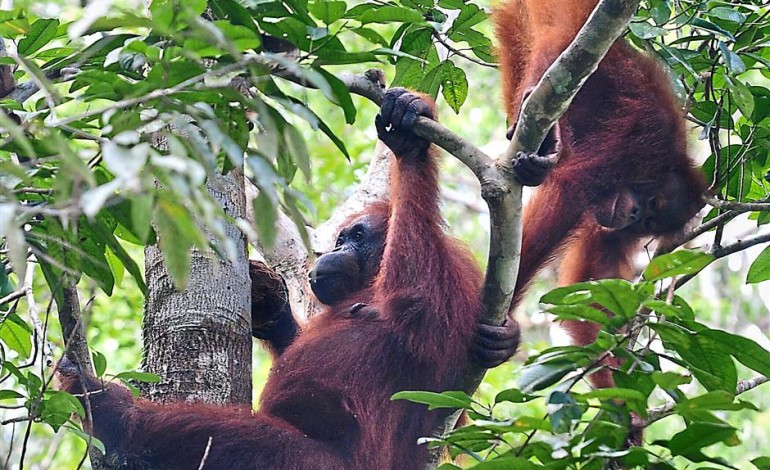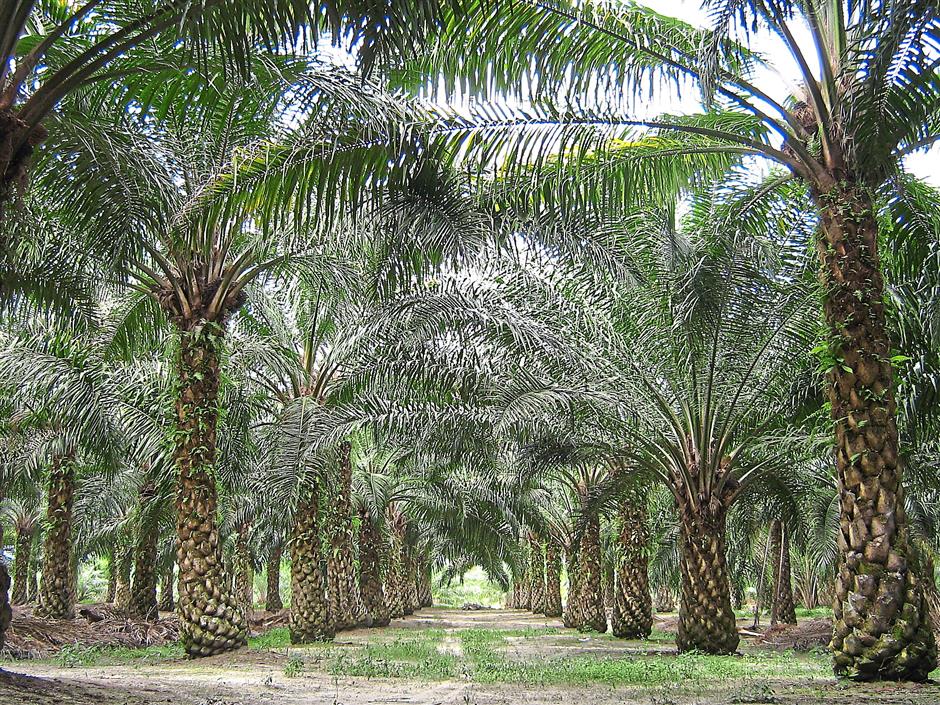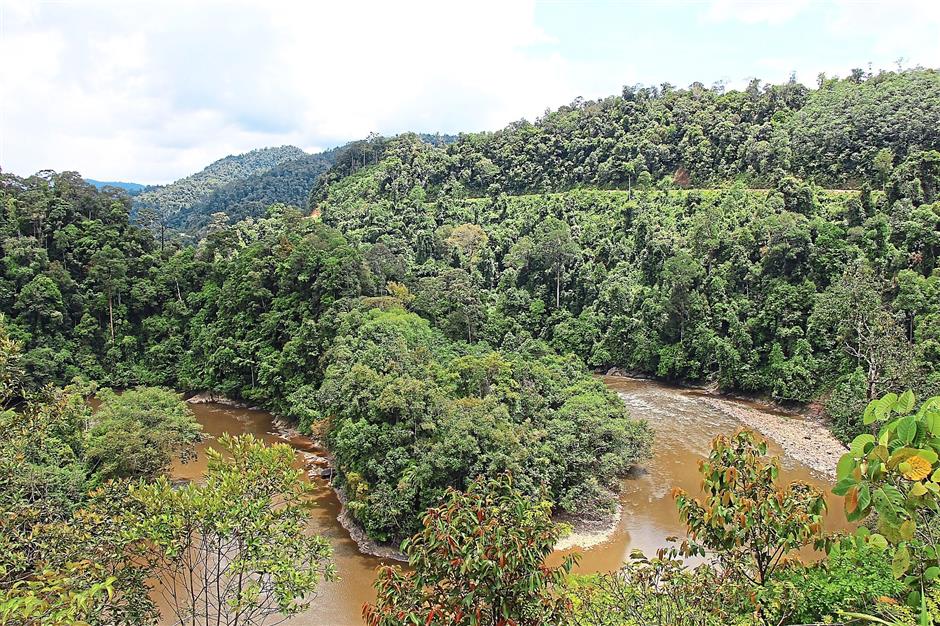
Orangutans roam freely at the Semenggoh Nature Reserve in Sarawak. Photo: Filepic
The iconic orangutans are a protected species in Malaysia and found only in Sarawak and Sabah.
In Sarawak, orangutans are found in two main areas: Batang Ai National Park and Lanjak Entimau Wild Life Sanctuary, where their numbers are estimated to be around 1,600. They roam freely in these two contiguous protected areas.
The other known areas where orangutans are found in Sarawak – albeit in lesser numbers – are Ulu Sebuyau National Park and Sedilu National Park.
In an effort to enhance management and protection of orangutans, the state government has collaborated with Wildlife Conservation Society (WCS) in 2015 to draw up an Orangutan Strategic Action Plan that will provide a holistic approach to the management and protection of these animals.
This plan includes expanding the boundary of the Batang Ai National Park to include the area around Ulu Sungai Menyang where surveys conducted estimated that 200 orangutans inhabited the area. The pledges to conserve these animals and their habitats were outlined in a speech by the Chief Minister on Dec 6 last year at the For Animals Conference 2015 in Kuching.
Malaysia is a signatory to multiple multilateral treaties on environmental protection – from the Rio 1992 Earth Summit, to the most recent Conference of Parties (COP 21) that took place in Paris in 2015.
Malaysia continues to honour the pledge made in 1992 to preserve 50% of land as forest area. This commitment by Malaysia has been recognised by the United Nations and the World Bank, among many others. This commitment illustrates that Malaysia is a recognised world leader in forest protection.
The most recent report from the UN Food and Agriculture Organization (FAO), the Global Forest Resources Assessment (FRA) 2015 measured Malaysia’s forest area as 22,195,100ha or 67.6% of land area, decreasing only slightly over the past 25 years and at a rate of decrease that is less than that of developed countries like Australia or Canada.

Currently the total area planted with oil palm in Sarawak is about 1.5 million hectares. Photo: Wikimedia Commons
However, between 2010 and 2015, Malaysia’s forest area has actually risen by an average of 14,000ha/year. In other words, Malaysia’s forest area is increasing, not decreasing. (Global Oils & Fats Business magazine Page 14&15, Vol. 13, Issue 1, 2016).
According to a statement from Sarawak Forestry Corporation, a Conservation Centre of Excellence (CCOE) for orangutan research has been established in Batang Ai National Park. The centre will serve as a base for researchers who will be conducting a wide range of research on orangutans. The research data and results would be used to draw up a comprehensive management plan for orangutans in Sarawak.
In 2015, the Chief Minister of Sarawak, Tan Sri Adenan Satem, launched the RIMBA Sarawak project (Research for Intensified Management of Bio-Rich Areas of Sarawak). This initiative implements Sarawak’s commitment to the international community to allow the forest estates of Sarawak, especially the Totally Protected Areas (TPAs), to be accessible to international researchers to conduct research.
One of the objectives of Rimba is to provide a platform for international collaborative research in developing intensive, practical conservation management procedures for bio-rich areas, including the conservation of orangutans in Sarawak.
The implementation of Rimba Sarawak is a timely reminder of Sarawak’s conservation efforts in the international arena.
In a taped speech presented at the Great Apes Survival Partnership (GRASP) meeting in Kota Kinabalu, Sabah, in July 2015, Sarawak’s Chief Minister had indicated that the Sarawak Government would embark on an orangutan-led environment and biodiversity policy.
Stance
The stance of Sarawak on the conservation of orangutans won the applause of WCS. WCS’s Director of Malaysia Program Dr Melvin Gumal told The Borneo Post (reported on Aug 7, 2015) that, “There is no other country that he is aware of worldwide that has set that kind of focus.”
The aforementioned orangutan habitats in Batang Ai National Park, Ulu Sebuyau National Park, Sedilu National Park and Lanjak Entimau Wild Life Sanctuary, are all designated as TPAs. Put another way, all the known orangutan habitats in Sarawak are under the protection of the state laws. To enter a national park, one requires a permit from the Controller of National Parks and Nature Reserves, while to enter a wildlife sanctuary one requires a permit from the Controller of Wildlife.
A researcher wishing to conduct research in a TPA must first obtain a research permit from the State Secretary of Sarawak; only then would a permit from the Controller of National Parks and Nature Reserves or the Controller of Wild Life be issued. These procedures are important to ensure the TPAs are focused on the protection and conservation of the biodiversity therein.

Kubaan-Puak area in Sarawak. Malaysia is a recognised world leader in forest protection. Photo: Filepic
The law in Malaysia is very clear when it comes to oil palm cultivation – permits are only issued for cultivation in logged-over areas or areas planted with other crops – or, in the case of Sarawak, on Native Customary Rights land in joint ventures with the natives. As such, the state government ensures that virgin jungles are not cleared for oil palm cultivation nor are the TPAs affected.
Currently the total area planted with oil palm in Sarawak is about 1.5 million hectares, comprising smallholders and Native Customary Rights (NCR) land owners, collaborations between private sector and government agencies, and private sector initiatives. The majority of these estates and smallholder areas are along the coastal areas in lowlands and riverine basins, which are far away from the protected areas that are orangutan habitats. The plantations and the protected areas can therefore co-exist, which is essential for the development of Sarawak.
The palm oil industry has experienced dynamic progress and has assumed a prominent role in steering the state’s economic growth. It has grown to be the main thrust of the agriculture sector, and has contributed significantly to the social and economic development of rural populations across the state.
Best opportunity
Oil palm cultivation is the best opportunity for NCR landowners to make full use of their idle lands. The Sarawak state government fully supports the conversion of NCR land into smallholder plots for oil palm cultivation, to ensure those families and communities can improve their standard of living. The state government’s support includes providing various schemes and incentives for such conversion.
The palm oil industry is a huge contributor to the state’s economy, contributing about RM1.9bil of sales tax revenue to the state government over the period 2010 to 2015. The palm oil industry provides job opportunities for locals and also acts as catalyst for rural growth.
Wherever sizable concentrations of oil palm estates emerge, the surrounding towns are energised with growth through both gainful employment and the opportunity to profit through providing services. The additional influx of workers in oil palm estates and mills further enhances the demand for goods and services in these growth areas, benefitting the local inhabitants and entrepreneurs. Oil palm estates throughout Sarawak create vast economic opportunities for thousands, while giving rural landowners enhanced returns on their lands.
Sarawak’s policies for conservation and economic growth are well-planned and are carried out systemically as provided for under the Constitution. The Wildlife Masterplan for Sarawak 1996, adopted by the state government, guides Sarawak to balance the need for conservation of wildlife and natural resources with the need for economic and social development of the state.
Currently, there are 30 national parks, four wildlife sanctuaries and 10 nature reserves in Sarawak covering 602,035.8ha (excluding bodies of water), which clearly shows the extent of the government’s commitment in ensuring that the natural habitats and ecosystem are conserved.
Ever since 1957, with the establishment of Bako National Park, the state has continuously over the years extended the areas under conservation and protection by creating these national parks, wildlife sanctuaries and nature reserves. The objective of the government is to increase this substantially, to reach one million hectares of TPAs by 2020 through the existing legal framework.
It is a generally accepted principle that the right to development and raising the standard of living of the people is the fundamental right of any nation. Sarawak is aiming to bring this prosperity to the people, especially the rural population, by encouraging them to cultivate oil palm, the most productive golden crop of this era. With the necessary infrastructure and funding provisions, these rural areas can be developed into thriving hinterlands promoting socio-economic growth. In setting aside protected areas for the conservation of habitats and species, the Sarawak government is committed to a balanced policy that allows for both land development for agriculture (including oil palm) and forest protection and conservation.
There is no conflict between oil palm development and orangutan habitats in Sarawak. This has been ensured by strategic planning and management of natural resources and land. Orangutans are located in the areas that have been gazetted as conservation areas. Oil palm plantations are located in other rural areas. Allegations that palm oil produced from Sarawak is linked to endangering the habitats of orangutans in Sarawak are without foundation. The Sarawak government’s commitment to conservation is clear. It has the support of the Sarawak palm oil industry, and concrete plans are in place to ensure that this commitment is implemented in practice. This is the Sarawak model of conservation and sustainable development. – Sarawak Oil Palm Plantation Owners Association (SOPPOA)
Taken from The Star